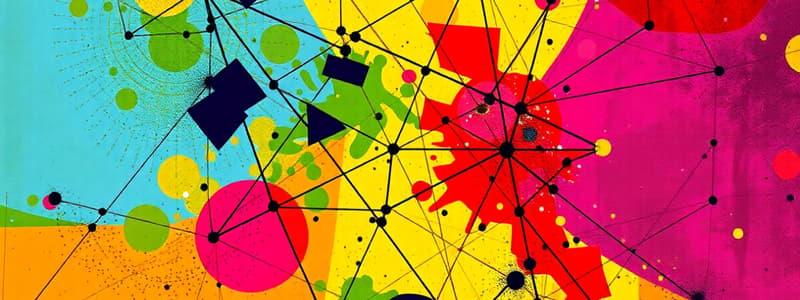Podcast
Questions and Answers
Match the following types of graphs with their definitions:
Match the following types of graphs with their definitions:
Directed graphs = Relationships flow in one direction Undirected graphs = Relationships flow bi-directionally Weighted graphs = Edges have additional data associated with them Cycles = A node can point back to itself, creating a loop
Match the following advantages/disadvantages with their respective graph representation methods:
Match the following advantages/disadvantages with their respective graph representation methods:
Adjacency matrix = Quadratic space complexity Adjacency list = Slower lookup compared to the matrix
Match the following graph traversal algorithms with their characteristics:
Match the following graph traversal algorithms with their characteristics:
Depth-First Search (DFS) = Explores a branch as deeply as possible before backtracking Breadth-First Search (BFS) = Visits nodes in layers starting from the root DFS = Implementation is recursive function BFS = Implementation uses a queue
Match the following applications of graphs with their examples:
Match the following applications of graphs with their examples:
Match the following features of graphs with their corresponding terms:
Match the following features of graphs with their corresponding terms:
Match the following statements about BFS and DFS:
Match the following statements about BFS and DFS:
Match the following graph representations with their advantages:
Match the following graph representations with their advantages:
Match the following types of graphs with real-world scenarios:
Match the following types of graphs with real-world scenarios:
Flashcards
What is a graph in data structures?
What is a graph in data structures?
A graph is a non-linear data structure that uses nodes and edges to represent relationships between entities. Nodes represent these entities, and edges connect them.
What are the two types of graphs based on edge direction ?
What are the two types of graphs based on edge direction ?
Directed graphs have relationships flowing in one direction, like Instagram followers. Undirected graphs have relationships flowing bi-directionally, like Facebook friendships.
Explain weighted graphs.
Explain weighted graphs.
Weighted graphs are graphs where each edge has additional information associated with it, such as distance between airports, cost of an airline ticket, or the strength of a connection.
What is a cycle in a graph?
What is a cycle in a graph?
Signup and view all the flashcards
What is an adjacency matrix in graph representation?
What is an adjacency matrix in graph representation?
Signup and view all the flashcards
How does an adjacency list represent a graph?
How does an adjacency list represent a graph?
Signup and view all the flashcards
Explain the concept of Depth-First Search (DFS).
Explain the concept of Depth-First Search (DFS).
Signup and view all the flashcards
How does Breadth-First Search (BFS) work?
How does Breadth-First Search (BFS) work?
Signup and view all the flashcards
Study Notes
Graphs
- A graph is a non-linear data structure used to represent relationships between entities.
- Nodes (or vertices) represent individual entities.
- Edges represent connections or relationships between nodes.
Types of Graphs
- Directed graphs: Relationships flow in one direction (e.g., Instagram followers)
- Undirected graphs: Relationships flow bi-directionally (e.g., Facebook friendships)
- Weighted graphs: Edges have additional data associated with them (e.g., distance between airports)
- Cycles: A node can point back to itself, creating a loop (e.g., an airplane returning to its departure airport)
Graph Representation
- Adjacency matrix: 2D array with rows and columns representing nodes. A '1' at the intersection indicates a connection, while a '0' indicates no connection.
- Advantages: Fast lookup and edge addition.
- Disadvantages: Quadratic space complexity and time complexity for node insertion.
- Adjacency list: Each node is linked to an array of its neighbors.
- Advantages: Efficient for graphs with many nodes and few edges, faster iteration over node edges.
- Disadvantages: Slower lookup compared to the matrix.
Graph Traversal Algorithms
- Depth-First Search (DFS): Explores a branch of the graph as deeply as possible before backtracking.
- Implementation: Recursive function.
- Breadth-First Search (BFS): Visits nodes in layers starting from the root node.
- Implementation: Queue.
Graph Applications
- Social networks: Representing connections between users (e.g., Facebook, Instagram)
- Recommendation engines: Connecting users, items, and preferences (e.g., Yelp, Netflix)
- Geographic data: Representing locations and connections (e.g., Google Maps)
Code Example: Building a Graph in JavaScript
- The code implements an undirected, unweighted graph using an adjacency list.
- Function
addNode: Adds a new node to the graph by creating a key-value pair in theadjacencyListmap. - Function
addEdge: Creates a connection between two nodes by adding each node to the other's adjacency list. - BFS Algorithm:
- Uses a queue to explore nodes in layers.
- Keeps track of visited nodes using a set.
- Uses
shiftto remove and access the first element of the queue.
- DFS Algorithm:
- Uses a recursive function to explore the graph.
- Keeps track of visited nodes using a set.
Time Complexity of Traversal Algorithms
- BFS and DFS: O(V + E), which is linear based on the number of nodes (V) and edges (E) in the graph.
Studying That Suits You
Use AI to generate personalized quizzes and flashcards to suit your learning preferences.




